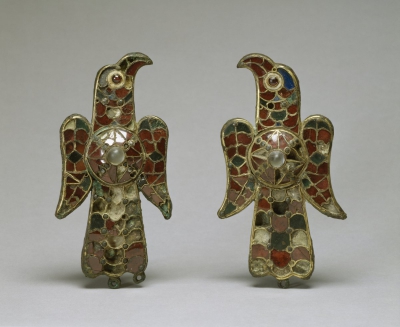Alaric I (; Gothic: , Alarks, "ruler of all"; c. 370 410 AD) was the first king of the Visigoths, from 395 to 410. He rose to leadership of the Goths who came to occupy Moesiaterritory acquired a couple of decades earlier by a combined force of Goths and Alans after the Battle of Adrianople.
Alaric began his career under the Gothic soldier Gainas and later joined the Roman army. Once an ally of Rome under the Roman emperor Theodosius, Alaric helped defeat the Franks and other allies of a would-be Roman usurper. Despite losing many thousands of his men, he received little recognition from Rome and left the Roman army disappointed. After the death of Theodosius and the disintegration of the Roman armies in 395, he is described as king of the Visigoths. As the leader of the only effective field force remaining in the Balkans, he sought Roman legitimacy, never quite achieving a position acceptable to himself or to the Roman authorities.
He operated mainly against the successive Western Roman regimes, and marched into Italy, where he died. He is responsible for the sack of Rome in 410, one of several notable events in the Western Roman Empire's eventual decline.
The Visigoths (; Latin: Visigothi, Wisigothi, Vesi, Visi, Wesi, Wisi) were an early Germanic people who, along with the Ostrogoths, constituted the two major political entities of the Goths within the Roman Empire in late antiquity, or what is known as the Migration Period. The Visigoths emerged from earlier Gothic groups, including a large group of Thervingi, who had moved into the Roman Empire beginning in 376 and had played a major role in defeating the Romans at the Battle of Adrianople in 378. Relations between the Romans and the Visigoths were variable, alternately warring with one another and making treaties when convenient. Under their first leader, Alaric I, the Visigoths invaded Italy and sacked Rome in August 410. Afterwards, they began settling down, first in southern Gaul and eventually in Hispania, where they founded the Visigothic Kingdom and maintained a presence from the fifth to the 8th centuries AD.The Visigoths first settled in southern Gaul as foederati to the Romans, a relationship that was established in 418. However, they soon fell out with their Roman hosts (for reasons that are now obscure) and established their own kingdom with its capital at Toulouse. They next extended their authority into Hispania at the expense of the Suebi and Vandals. In 507, however, their rule in Gaul was ended by the Franks under Clovis I, who defeated them in the Battle of Vouillé. After that, the Visigoth kingdom was limited to Hispania, and they never again held territory north of the Pyrenees other than Septimania. An elite group of Visigoths came to dominate the governance of that region at the expense of those who had previously ruled there, particularly in the Byzantine province of Spania and the Kingdom of the Suebi.
In or around 589, the Visigoths under Reccared I converted from Arianism to Nicene Christianity, gradually adopting the culture of their Hispano-Roman subjects. Their legal code, the Visigothic Code (completed in 654), abolished the longstanding practice of applying different laws for Romans and Visigoths. Once legal distinctions were no longer being made between Romani and Gothi, they became known collectively as Hispani. In the century that followed, the region was dominated by the Councils of Toledo and the episcopacy. Little else is known about the Visigoths' history during the 7th century, since records are relatively sparse. In 711, an invading force of Arabs and Berbers defeated the Visigoths in the Battle of Guadalete. The Visigoth king, Roderic, and many members of their governing elite were killed, and their kingdom rapidly collapsed. This was followed by the subsequent formation of the Kingdom of Asturias in northern Spain and the beginning of the Reconquista by Christian troops under Pelagius.During their governance of Hispania, the Visigoths built several churches that survived. They also left many artifacts which have been discovered in increasing numbers by archaeologists in recent years. The Treasure of Guarrazar of votive crowns and crosses are the most spectacular. They founded the only new cities in western Europe from the fall of the Western half of the Roman Empire until the rise of the Carolingian dynasty. Many Visigothic names are still in use in modern Spanish and Portuguese languages. Their most notable legacy, however, was the Visigothic Code, which served, among other things, as the basis for court procedure in most of Christian Iberia until the Late Middle Ages, centuries after the demise of the kingdom.

 English
English  español
español  français
français  português
português  русский
русский  العربية
العربية  简体中文
简体中文 
